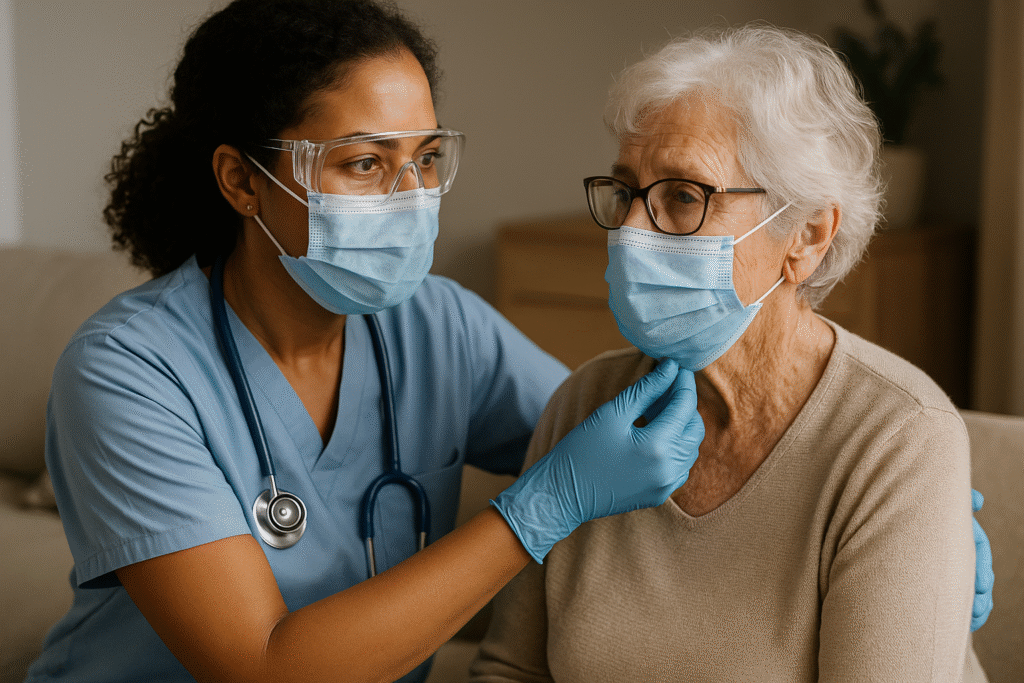Infection Control Protocols for Home Healthcare Workers are essential in safeguarding both caregivers and vulnerable patients in home environments.
Unlike clinical settings, home healthcare presents unique challenges: varied sanitation levels, shared family spaces, and limited infection control infrastructure. With growing demand for in-home care, it’s crucial to implement robust and consistent infection prevention practices.

This article outlines the key infection control measures every home healthcare provider should follow, from PPE use and hand hygiene to safe handling of medical waste and patient education.
- Why Infection Control Is Critical in Home Healthcare
- Key Infection Control Protocols for Home Healthcare Workers
- Environmental Cleaning
- Safe Handling of Medical Waste and Sharps
- Respiratory Hygiene and Cough Etiquette
- Protocols for Handling Infections and Outbreaks
- Educating Patients and Family Members
- Vaccination and Worker Health Monitoring
- Regulatory and Best Practice Guidelines
- Final Thoughts on Infection Control Protocols for Home Healthcare Workers
Why Infection Control Is Critical in Home Healthcare
Home healthcare workers care for elderly, immunocompromised, or chronically ill patients—many at high risk of infection. Infections such as MRSA, C. difficile, COVID-19, and influenza can spread rapidly if protocols are not strictly followed.
The Centers for Disease Control and Prevention (CDC) guidelines on home healthcare (DoFollow) emphasize that providers must adapt standard precautions to the home setting, where conditions may be unpredictable and resources limited.
Key Infection Control Protocols for Home Healthcare Workers
1. Strict Hand Hygiene Practices
Hand hygiene is the single most important measure. Home healthcare workers must wash their hands:
- Before and after patient contact
- Before donning gloves and after glove removal
- After contact with any bodily fluids, soiled materials, or contaminated surfaces
Use alcohol-based hand rubs (60–95% alcohol) when hands are not visibly soiled, and soap and water for visibly dirty hands or after exposure to C. difficile.
2. Proper Use of Personal Protective Equipment (PPE)
PPE must be selected based on the anticipated level of exposure:
- Gloves: For any contact with blood, body fluids, or contaminated surfaces
- Gowns: When there’s a risk of soiling from spills or patient contact
- Masks/Face Shields: When there’s a risk of respiratory droplet exposure or during wound care
- Eye Protection: During suctioning or procedures with a splash risk
All PPE should be disposed of properly in the patient’s home or sealed for transport.
Environmental Cleaning

Home settings vary in cleanliness and may lack proper ventilation. Healthcare workers should:
- Clean reusable equipment (stethoscopes, blood pressure cuffs) between patients with EPA-approved disinfectants
- Use single-use disposable items when possible
- Disinfect commonly touched surfaces (bedside tables, doorknobs) before and after procedures
- Avoid placing bags or supplies on the floor—use barrier pads or disposable covers
Educate patients and caregivers on cleaning routines to maintain infection control between visits.
Safe Handling of Medical Waste and Sharps
Improper disposal of sharps or soiled items in home settings poses significant risks. Home healthcare workers should:
- Carry portable, puncture-proof sharps containers
- Seal and label all contaminated waste before removal
- Instruct families never to reuse or touch used medical items
- Follow local and provincial guidelines for waste disposal (e.g., Government of Canada biomedical waste management)
Respiratory Hygiene and Cough Etiquette
Patients with coughs or respiratory infections should be:
- Encouraged to wear a mask during care
- Taught to cover their mouths with a tissue or elbow when coughing
- Isolated in a single room if possible during home care visits
Home healthcare providers should wear surgical masks or respirators based on the risk level and type of illness.
Protocols for Handling Infections and Outbreaks
If a patient is diagnosed with an infectious disease:
- Notify your agency and follow their infection reporting protocols
- Reschedule non-urgent visits to reduce exposure
- Implement transmission-based precautions (contact, droplet, airborne)
- Use dedicated equipment when caring for infected patients
Refer to internal care guidelines or OHSE training modules for protocol updates and outbreak-specific measures.
Educating Patients and Family Members
Infection control doesn’t stop with the healthcare worker—it requires patient and family involvement.

Education should cover:
- Handwashing techniques
- Safe storage of medications and supplies
- Cleaning schedules for shared equipment
- Proper handling and disposal of dressings or bandages
Use easy-to-read materials and visual aids where possible. Internal links to patient education materials or OHSE.ca (DoFollow) can support home learning.
Vaccination and Worker Health Monitoring
Home healthcare workers should be up to date on:
- Annual influenza vaccines
- COVID-19 vaccines and boosters
- Hepatitis B vaccination
- TB screening as per employer policy
If symptoms of illness appear, workers must report immediately, avoid patient contact, and follow sick leave protocols.
Regulatory and Best Practice Guidelines
Follow these core standards:
- CDC Standard Precautions
- Canadian Standards Association (CSA Z317.13) for infection control in home care
- WHMIS labeling for chemical disinfectants
- IPAC Canada guidelines for home health infection prevention
Compliance helps prevent the spread of infection and shields providers from liability.
Final Thoughts on Infection Control Protocols for Home Healthcare Workers
Infection Control Protocols for Home Healthcare Workers are a cornerstone of quality in-home medical care. Proper hand hygiene, PPE use, waste management, and patient education are essential for preventing transmission in less controlled environments.
As home healthcare becomes more common, keeping workers and patients safe depends on consistent adherence to best practices and continuous training.
Empowering providers with knowledge and tools ensures better outcomes and safer homes.

No comments yet